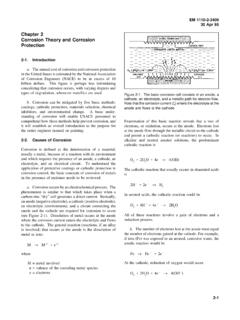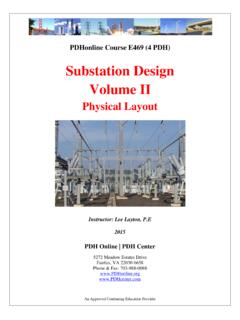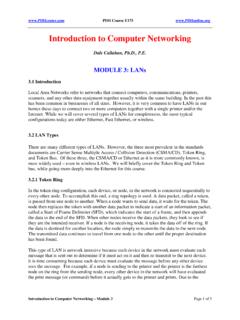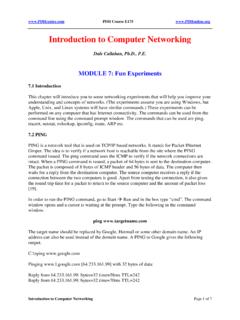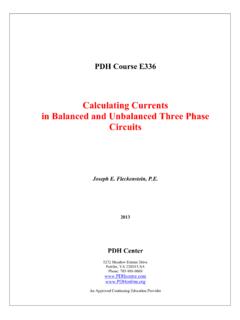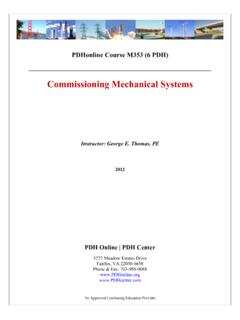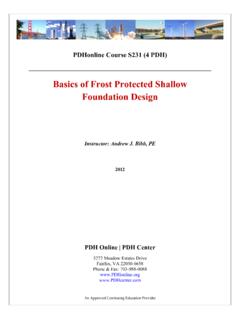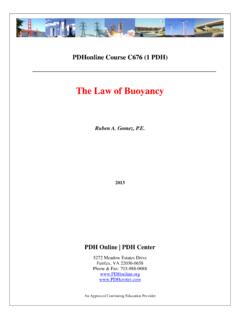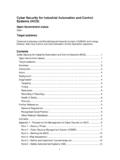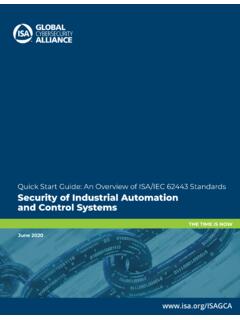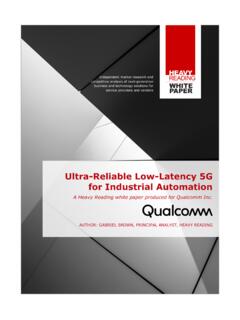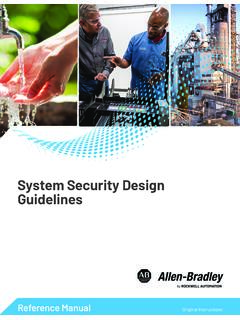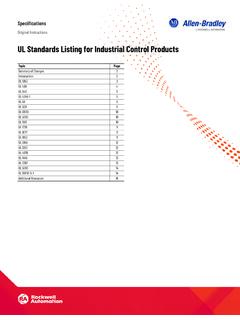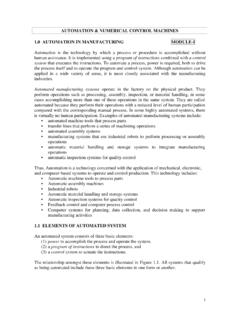Transcription of Industrial Communications and Control Protocols
1 PDHonline Course E497 (3 PDH) Industrial Communications and Control Protocols By Michael J. Hamill, Copyright 2016 Updated 2019 PDH Online | PDH Center 5272 Meadows Estate Drive Fairfax, VA. 22030-6658 Phone: 703-988-0088 An Approved Continuing Education Provider PDHonline Course E497 Hamill, Industrial Communications and Control Protocols 2 Index Introduction 3 Protocol: A definition 3 Digital Data Basics 3 Differences in Controller Types 5 Diversity in the PLC/DCS/PAC market and its problems 5 Networks, Nodes, and Topologies 7 The OSI Model and its importance 11 Hardware and Connecting Cables 12 Communication methods 14 Deterministic Communications 15 Interface standards and devices 16 Common Features in Protocols 18 Some Notable automation Companies 19 Proprietary and Open Protocols 20 The HART protocol 20 TCP/IP 21 Control Protocols 22 Modbus and some of its variants 23 Modbus Plus 23 Rockwell / Allen-Bradley Protocols 23 Some Important Open Protocols 25 The Fieldbus Foundation and its work 25 FOUNDATION Fieldbus H1 25 FOUNDATION Fieldbus HSE 26 The PROFIBUS Standards 27 PROFIBUS PA 27 PROFIBUS DP 28 PROFINET 28 Protocols used
2 With HMIs 28 W indows OS and OPC 29 Local operator terminals 30 Transmitters, actuators and Protocols 30 Disadvantages of using Protocols 30 Summary 31 Appendix: Overview of the Modbus RTU Protocol 32 References 34 Endnotes 34 PDHonline Course E497 Hamill, Industrial Communications and Control Protocols 3 Introduction This course is intended to benefit readers by: Explaining what Protocols are Explaining what Communications and Control Protocols do Explaining how use of Protocols makes it easier for controllers to operate Describing some commonly-used network topologies Describing some hardware and cables used for digital Communications Detailing some different ways of transmitting data over networks Condensing often confusing information about Protocols Explaining how Protocols interrelate with networks and the Internet Describing some commonly used Protocols and their uses Readers who have experience with.
3 Or some knowledge about one or more of the following technologies will benefit most from this course: Programmable Logic Controllers (PLCs); Distributed Control Systems (DCSs); or Programmable Automatic Controllers (PACs). This course also discusses networks in some detail. Protocols are best explained along with a discussion about some basic features of networks. Protocol: A definition It's worthwhile to begin by defining Protocol. The author's definition is: a method for digital data Communications between two or more devices in different locations, or on a network. There are many Protocols in use around the world.
4 This course focuses on Protocols used by PLCs, DCSs, PACs, and devices existing on the same network as Industrial controllers. Some Protocols used with controllers are for data Communications only, usually by sensors and transmitters. Others are used for both data Communications and Control applications. Digital Data Basics Digital data is a natural choice for Communications . The smallest unit of digital data is a Bit, or binary digit, and it has just two states: Off, represented by a 0; and On, represented by a 1. Since the 1960s, most computerized devices have relied on miniaturized, two-state transistors that are either off or on.
5 And a voltage associated with the transistor is either low (0) or high (1). A bit s value is represented using base 2, and can only be 0 or 1. Digital data can be generated and transmitted very quickly by electronic equipment. PDHonline Course E497 Hamill, Industrial Communications and Control Protocols 4 Almost all transmitted data is at least one byte long. A byte consists of 8 consecutive bits, or binary digits. A byte can have up to 256 (28) values. In reality, data is frequently communicated in 2, 4 or 8 byte units. A data unit with 2 bytes (16 bits) is often called a Word. Measurements that mean something in the real world - levels, pressures, temperatures, etc.
6 - can easily be represented with 2 or 4 bytes. So can the ranges of set points. Likewise the On or Off state of a device like a motor. W ithin computers and microprocessors, arithmetic operations on data that has a digital equivalent is readily done. They can easily manipulate data in binary, or base 2. Example: Assume a tank s level transmitter is calibrated so 0% is 0 feet, and 100% signal is 10 feet. If a 2-byte word is used to represent this data, than at 5 feet (50% level) that will be the same as 32,767, or 0111111111111111 in binary (and 7 FFF in hexadecimal, , hex - base 16). At 100% level, that will equate to 65,535 (hex: FFFF).
7 Before microprocessor-based controllers became the dominant Control technology in the early 1980s, controllers for applications like refineries, chemical plants, and power plants mostly used analog electronic Control systems. Analog signals vary in a range. These analog systems had some serious limitations. One was that analog signals were susceptible to being corrupted by electrical noise and unintentional grounds. Another was that settings and calculated values in Control loops tended to drift over time, especially as components heated up. Digital data Communications through Protocols has the advantages that it is inherently more stable, reliable, and less susceptible to electrical noise than analog signals.
8 Another advantage of digital Communications is that a lot of data can be communicated on a single network or fieldbus cable. This reduces end users needs for installing controller input and output modules, wiring, conduit, etc. It also lets users connect different types of devices to the same Communications cable, such as transmitters and actuators. And it also makes it easier find the sources of problem conditions readily. Fieldbus is defined as a family of Industrial computer network Protocols used for real-time distributed Control , standardized as IEC 61158. 1 PDHonline Course E497 Hamill, Industrial Communications and Control Protocols 5 This course is progressing to a discussion of Protocols .
9 But worldwide, plants are continuing to use sensors, transmitters and actuators that transmit or respond to analog signals. Controllers handle that by embedding Analog-to-Digital (A/D) and Digital-to-Analog (D/A) converters in input and output modules. For example, most incoming analog signals are converted from a voltage1 to a 16-bit integer within a controller. That makes it easy for a controller to use the data. Differences in Controller Types The two primary types of controllers in use are PLCs and DCSs (see page 3). The two technologies were developed for different markets in the 1970s. PLCs were meant for mostly for manufacturing applications where most devices were turned on and off; raised; lowered; rotated; moved sideways; and where users wanted to compare the state of something at the end of an operation to its beginning state.
10 They also found many uses in applications where a process occurred in a repeated cycle. PLC functions were (and still are) mostly implemented using ladder logic symbols, which technicians understand. DCSs, on the other hand, replaced earlier systems and equipment in applications that involved mostly continuous measurement of process variables and ongoing Control of processes such as at oil refineries and power plants. DCSs replaced pneumatic controls; analog single loop controllers; and analog Control systems. DCSs predominantly use function block programming. DCSs were (and remain) more expensive than PLCs because the reliability requirements are more demanding, in most cases, than in PLC applications.

